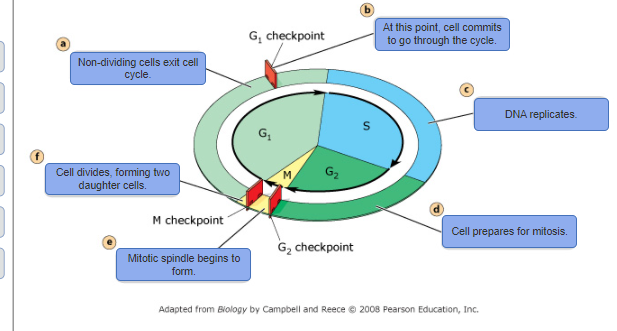The BIO (Biotechnology Industry Organization) meeting held in Philadelphia in June 2005 brought together worldwide leaders from the biotechnology and pharmaceutical industries. Concurrently, BioDemocracy 2005, a group composed of people seeking to highlight hazards from widespread applications of biotechnology, also met in Philadelphia. The benefits of biotechnology are outlined in your text. Predict some of the risks that were no doubt discussed at the BioDemocracy meeting.
-Safety of genetically modified organisms to human health.
-Ecological harmony.
-Biotechnical applications to weapons development
To understand how cells function as the fundamental unit of life, you must first become familiar with the individual roles of the cellular structures and organelles.

Two fundamental types of cells are known to exist in nature: prokaryotic cells and eukaryotic cells (like the one shown in the Tour of an Animal Cell animation). Both prokaryotic and eukaryotic cells carry out all of the processes necessary for life, but they differ in some important ways. In this activity, you will identify which cell structures are found only in prokaryotic cells, only in eukaryotic cells, or in both types of cells.
pro- nucleoid
euk- nucleolus, lysosome, mitochondria
both- ribosomes, plasma membrane, flagella


Which list of steps in the eukaryotic cell cycle is given in the correct order? (step order listed left to right)
. . . G1 - S - G2 - M - G1 . . .
Haploid cells do not undergo mitosis.
False
Each of the following events occurs during mitosis except _______.
polar microtubules contract, pulling attached chromosomes toward the poles
As in most areas of biology, the study of mitosis and the cell cycle involves a lot of new terminology. Knowing what the different terms mean is essential to understanding and describing the processes occurring in the cell.
1. DNA replication produces two identical DNA molecules, called
SISTER CHROMATID(S), which separate during mitosis.
2.
After chromosomes condense, the CENTROMERE(S) is the region where the
identical DNA molecules are most tightly attached to each other.
3. During mitosis, microtubules attach to chromosomes at the
KINETOCHORE(S)
4. In dividing cells, most of the cell's
growth occurs during INTERPHASE
5. The MITOTIC SPINDLE(S)
is a cell structure consisting of microtubules, which forms during
early mitosis and plays a role in cell division.
6.
During interphase, most of the nucleus is filled with a complex of
DNA and protein in a dispersed form called CHROMATIN
7.
In most eukaryotes, division of the nucleus is followed by
CYTOKINESIS, when the rest of the cell divides.
8. The
CENTROSOME(S) are the organizing centers for microtubules involved in
separating chromosomes during mitosis.
Many organisms contain cells that do not normally divide. These cells exit the cell cycle before the G1 checkpoint. Once a cell passes the G1 checkpoint, it usually completes the cell cycle--that is, it divides.
- The first step in preparing for division is to replicate the cell’s DNA in the S phase.
- By the end of G2 phase, the volume of the cell has roughly doubled.
- In early M phase, the centrosomes move away from each other toward the poles of the cell, in the process organizing the formation of the mitotic spindle.
- At the end of the M phase when mitosis is complete, the cell divides (cytokinesis), forming two genetically identical daughter cells.

As the chromosomes of a parent cell are duplicated and distributed to
the two daughter cells during cell division, the structure of the
chromosomes changes.
Answer the three questions for each phase of
the cell cycle by dragging the yes and no labels to the appropriate
locations in the table.
Note: Assume that by the end of the M
phase, the parent cell has not yet divided to form two daughter cells.
Are sister chromatid present in all or part of this phase?
G1-no
S-yes G2-yes Beginning of M-yes End of M-no
Is the DNA
condensed in all or part of this phase?
G1- no S-no G2-no
Beginning of M-yes End of M-yes
Does the cell contain
twice as much DNA in this phase as it did in the G1 phase?
G1- no S-yes G2-yes Beginning of M- yes End of M-yes
Separation of sister chromatids occurs _______
at anaphase in mitosis and anaphase II in meiosis
The end result of meiosis is four haploid daughter cells.
true
Novel combinations of genes can arise from _______.
reciprocal exchange of DNA between homologs during prophase ISubmit
The phenotype of an organism is _______.
the observed features of an organism
The haploid number of a species is _______.
n
(the haploid number is the number of chromosomes in gametes after meiosis.)
The functional unit of heredity is a _______.
gene
The theory of epigenesis states that _______.
adult structures in the organism develop de novo from substances present in the egg
What are some of the impacts of biotechnology on crop plants in the United States?
all of them
- Quicker identification of hazardous organisms in food
- The
development of transgenic crops
- The spread of transgenes from
genetically modified crops to wild plants
- The development of
pest-resistent crops
- The development of nutritionally-enhanced
crops
- The development of herbicide-resistant crops
What is an example of translational medicine?
A gene product associated with lower cholesterol levels is used to develop a treatment for high cholesterol.
If you were in a position to control the introduction of a GM primary food product (rice, for example), what criteria would you establish before allowing such introduction?
-likelihood of cross-pollination
-environmental impact
Summarize the arguments for and against patenting genetically modified organisms.
For Patenting:
- Patenting encourages innovation
-
Patenting allows the cost of discovery to be recovered
Against Patenting:
- Patenting stifles free
enterprise
- Patenting may limit access to products
-
Patenting forces farmers to grow a limited suite of crops
Wrong statements:
- Patenting sets fixed prices
-
Patenting makes the modification mechanism public
- Patenting
allows only one company to develop the technology
During which stage of prophase I does crossing over take place?
Pachynema (Crossing over occurs during pachynema when bivalents are closely paired.)
A tetrad is composed of one pair of homologous chromosomes at synapsis of prophase I.
true
(Chromosomes are duplicated during interphase; at synapsis of prophase I, one chromosome (with two chromatids) in a tetrad is paternally inherited while the other is maternally inherited.)
When do sister chromatids separate during meiosis?
Anaphase II
How has the use of model organisms advanced our knowledge of the genes that control human diseases?
...
What are the basic subunits of DNA and RNA?
nucleotides
Define genotype and phenotype.
- genotype of an organism is defined as its specific allelic or genetic constitution.
- The phenotype of an organism is defined as its observable sum of features.
How do alleles fit into your definitions?
-A population can contain many alleles for a gene, but an individual diploid organism has only two alleles for a gene.
-Alleles are alternative forms of a gene.
-Differenet alleles may produce differences in the phenotype of an organism.
Why do you think discoveries in genetics have been recognized with so many Nobel Prizes?
-Genetics guided our understanding of living systems.
-Genetics aided rational drug design.
-Genetics helps to explain species stability and diversity.
-Genetics provides the framework for universal biological processes.
How does genetic information flow in an organism?
DNA → RNA → protein
Contrast chromosomes and genes.
Genes take part in the production of proteins through the processes of transcription and translation. They are the functional units of heredity. Chromosomes carry genes and take part in cell division during mitosis and meiosis.
Which term describes the complete haploid content of DNA contained within an organism?
genome
How is genetic information encoded in a DNA molecule?
Genetic information is encoded in DNA by the sequence of bases.
The study of the set of proteins present in a cell is referred to as _______.
proteomics
Identify the central dogma of molecular genetics.
DNA →→ RNA →→ protein
How does the central dogma of molecular genetics serve as the basis of modern genetics?
Because DNA and RNA are discrete chemical entities, they can be isolated, studied, and manipulated in a variety of experiments that define modern genetics.
What is the chromosome theory of inheritance?
It states that inherited traits are controlled by genes residing on chromosomes that are transmitted by gametes.Submit
How is it related to Mendel's findings?
The chromosome theory of inheritance is based on the parallels between Mendel's model of heredity and the behavior of chromosomes during meiosis.Submit
Describe Mendel's conclusions about how traits are passed from generation to generation.
Mendel hypothesized that traits in peas are controlled by specific unit factors. He suggested that unit factors occur in pairs and that unit factors separate from each other during gamete formation.Submit
All of the following are desirable qualities in a model organism EXCEPT __________.
long life span
How many different proteins, each with a unique amino acid sequence, can be constructed with a length of 4 amino acids?
Since each of the 20 amino acids is chemically distinct and each can, in principle, occur at any position in a protein chain, there are 20 × 20 × 20 × 20 = 160,000 different possible
Given the state of knowledge at the time of the Avery, MacLeod, and McCarty experiment, why was it difficult for some scientists to accept that DNA is the carrier of genetic information?
Genes possess a variety of functions. Since proteins can contain up to 20 different amino acids, while DNA is made up of only four different nucleotides, proteins should have more functional variations. It seemed likely that proteins should be the genetic material.Submit
Which of the following cell structures are directly involved in protein synthesis?
rough endoplasmic reticulum and ribosomes
(Ribosomes are the sites of protein translation, and some ribosomes attach to the rough endoplasmic reticulum.)
If you wrote a brief essay discussing the impact of recombinant DNA technology on genetics as we perceive the discipline today, what applications of recombinant DNA technology should be included?
-Plant and animal husbandry
-Plant and animal
production
-Forensics
-Drug development
-Understanding
gene function
-Medical advances
We all carry about 20,000 genes in our genome. So far, patents have been issued for more than 6000 of these genes.
What are the arguments for and against human gene patenting by companies and individuals?
-Mechanisms need to be in place to protect consumers to ensure that
relatively free and fair access to genetic tools is
available.
-Preventing the holding of patents for genes or
genetic tools could reduce the incentive for pursuing the research
that produces genes and genetic tools.
-Mechanisms need to be in
place to protect consumers to ensure that relatively free and fair
access to genetic tools is available.
Preventing the holding of
patents for genes or genetic tools could reduce the incentive for
pursuing the research that produces genes and genetic
tools.
Patents can protect the investments of individuals and
institutions that develop needed and useful products.
Patents can protect the investments of individuals and institutions that develop needed and useful products.
Mechanisms need to be in place to protect consumers to ensure that
relatively free and fair access to genetic tools is
available.
Preventing the holding of patents for genes or genetic
tools could reduce the incentive for pursuing the research that
produces genes and genetic tools.
Patents can protect the
investments of individuals and institutions that develop needed and
useful products.
acrocentric chromosome